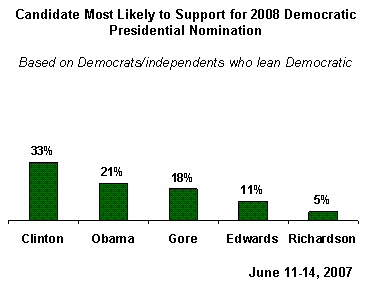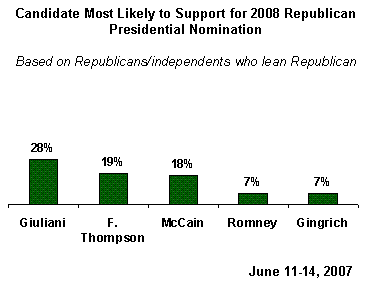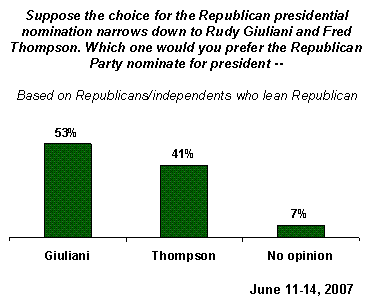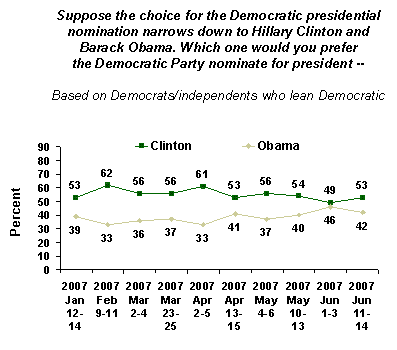GALLUP NEWS SERVICE
PRINCETON, NJ -- With no incumbent president or vice president running for the 2008 presidential nominations, it is perhaps not surprising that both of the major parties have competitive races, with multiple candidates jockeying for second, if not first, place. Still, the current outlines of voter preferences in the Republican and Democratic nomination battles are remarkably similar.
According to the latest USA Today/Gallup poll of national adults, conducted June 11-14, 2007, each race is characterized by a front-runner attracting about 30% of the potential primary vote nationwide, followed by two candidates garnering about 20% support each in a close contest for second place, and a slew of weaker candidates, each supported by no more than 11%.
Continuing the parallels, the race for second place in both parties features one announced candidate who has earned fairly steady support throughout the year (mostly failing to build momentum) and one unannounced candidate with growing support, just recently pulling into a tie for second.
The Democratic Contest
The current Democratic front-runner is Sen. Hillary Clinton. She is favored by 33% of Democrats and independents who lean Democratic -- about average for her this year.
A USA Today/Gallup Poll conducted earlier this month found Clinton's chief rival, Sen. Barack Obama, pulling even with Clinton. However, in the current poll Obama has fallen back to a tie for second place with former Vice President Al Gore. At 21%, current support for Obama is near the low end of the support range seen for him since January, while Gore's 18% ties with an early March poll as his best result.
Former Sen. John Edwards, once tied with Gore for third place, has been stalled in the 11% to 12% range since May. The only other candidate earning the support of at least 5% of Democrats is New Mexico Gov. Bill Richardson.

The Republican Contest
On the Republican side, former New York Mayor Rudy Giuliani has managed to hang on to his first-place position through most of 2007, but has a somewhat weaker level of support today than earlier this year. His current 28% of the vote is at the bottom of the support range seen for him since January, and is well below the high point of 44% he had in a March Gallup Poll.
A stiff battle for second place in the Republican race is now underway between veteran candidate Sen. John McCain and newcomer Fred Thompson, the former senator who only recently formed an exploratory committee to start raising funds and who has yet to formally announce his candidacy. Support for Thompson has nearly doubled since Gallup's last poll, from 11% in early June to 19% today. McCain is now at 18%. This is similar to the 19% he garnered earlier this month, and an average of 22% in two May polls, but is well below his high point of 28% last December.
Support for Massachusetts Gov. Mitt Romney is now at 7%, lower than the 12% seen in early June but typical of the support level he has received since announcing his candidacy in February. Former Speaker of the House Newt Gingrich (whose candidacy is still in question) also comes in at 7%. None of the other eight Republicans named in the poll is supported by more than 3% of Republicans.

"Narrow-Downs"
Not only do Clinton and Giuliani lead their respective races among the full fields of candidates running in their parties, but they are also the top choices for their respective parties' nominations when the races are narrowed down to just themselves and one of their leading opponents.
On the Republican side, Gallup asked Republicans and independents who lean Republican to name their preference if the choice for the Republican presidential nomination narrows down to Giuliani and Fred Thompson -- the first Giuliani-Thompson face-off Gallup has measured. A slight majority of Republicans (53%) pick Giuliani while 41% choose Thompson. This 12-point lead for Giuliani is slightly greater than the nine-point lead he has among the full field. (In the early June poll, Giuliani led McCain on this type of measure by 18 points, 56% vs. 38%.)

On the Democratic side, Gallup asked Democrats and independents who lean Democratic to name their preference if the choice for the Democratic presidential nomination narrows down to Clinton and Obama -- a match-up Gallup has been tracking since January. Clinton now leads Obama by 11 percentage points on this measure, 53% vs. 42% -- nearly identical to Giuliani's current lead over Thompson.
Clinton has held an advantage over Obama on this measure all year, averaging 19 percentage points from January through May, but varying quite a bit within that period. Clinton's greatest lead over Obama in this two-candidate match-up was 29 points in mid-February, and her smallest was 3 points in Gallup's early June poll.

Survey Methods
Results are based on telephone interviews with 1,007 national adults, aged 18 and older, conducted June 11-14, 2007. For results based on the total sample of national adults, one can say with 95% confidence that the maximum margin of sampling error is ±3 percentage points.
For results based on the sample of 393 Republicans or Republican leaners, the maximum margin of sampling error is ±5 percentage points.
For results based on the sample of 516 Democrats or Democratic leaners, the maximum margin of sampling error is ±5 percentage points.
In addition to sampling error, question wording and practical difficulties in conducting surveys can introduce error or bias into the findings of public opinion polls.